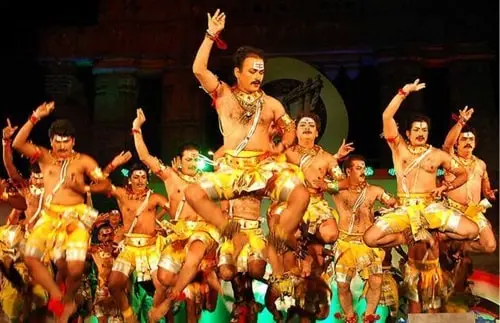Telengana, the state from the south western part of India has a long running rich culture filled with tradition and exquisite artistic activities. The people of Telengana are art lovers just as they are strong religious devotees. Through their different works and activities, they practice their native art forms. The dances, among these art forms, hold an optimum importance. Not only that Telengana has a good number of dance forms, but also that these forms are practiced the people of the state time to time based on festivals, seasons and occasions. Here we will be discussing about these dance forms in brief.
List of Traditional Dances Of Telangana
1. Perini Sivatandavam: The Dance of Warriors

Perini Sivatandavam, the “Warrior’s Dance,” is Telangana’s ancient and astounding cultural treasure. This magnificent Kakatiya-era dancing form was Shiva-dedicated. Perini Sivatandavam is a spiritual and physical powerhouse. Dancers maneuver and posture like combat fighters. Strength, agility, and precision are shown in this dance. Traditional dress, jewelry, and face paint are only worn by men. The elegant design enhances the performance. Harmonium and mridangam provide Perini Sivatandavam depth and resonance. Harmonium melodies and mridangam rhythms lead listeners to a spiritual and emotional experience. Beyond its physique and spectacle, Perini Sivatandavam demonstrates the performers’ devotion to Lord Shiva. Mysticism makes the dance revered. It honors Telangana’s fighting heritage. A cultural treasure that spans generations, Perini Sivatandavam is more than a spectacle. The dance celebrates Telangana’s warrior spirit and spiritual commitment to Lord Shiva, showing art’s power to convey dedication, tradition, and lineage. Perini Sivatandavam’s strength, passion, and brilliance will revolutionize Telangana’s culture.
2. Lambadi Dance: A Glimpse into Nomadic Life
Lambadi, or “Banjaras,” dance their nomadic culture. The colorful Lambadi Dance, lead by women, symbolizes their nomadic lifestyle. Lambadi Dance vibrantly depicts everyday life, love, and harmony with nature. Dancers with flowing skirts and jewels narrate these tales with expressive gestures and impeccable technique. They demonstrate community pride with bright outfits and traditional jewelry. Lambadi Dance has dholaks and flutes. The dholak’s thunderous pounding and flute’s sweet melodies make the concert memorable. Lambadi Dance shows their might. Their capacity to appreciate and produce despite migration is symbolized. Dance links generations culturally. Lambadi Dance displays their rich culture and lifestyle. It shows simplicity and tradition in a changing world. Lambadi Dance transports one to their nomadic culture’s bright, rhythmic delight, resilience, and celebration.
3. Dhimsa: Celebrating Village Life
A lovely Telangana group dance, Dhimsa, commemorates rural life. This joyous dancing style led by women represents solidarity, friendliness, and shared experiences that bind communities. Dancers form a circle and glide gently to the rhythmic pulses of traditional instruments like the dappu. This rhythm provides a beautiful symphony of coordinated steps that tell a story of tradition and togetherness. A rich visual tapestry makes Dhimsa fascinating. Dancers with bright sarees and traditional jewelry are gorgeous. Their clothing and jewelry accentuate the performance. Dhimsa mostly covers nature, agriculture, and rural Telangana life. The dance highlights rural life’s simple but profound pleasures, nature’s beauty and the land’s labor. Beyond entertainment, Dhimsa values community, shared experiences, and culture. Tradition and identity are strengthened. Dhimsa, a joyful rural Telangana dance, is gorgeous. It cheerfully praises community, nature, and rural life’s ageless beauty. Dhimsa culture evokes longing for community and heritage.
4. Kolatam: The Dandiya of Telangana
Kolatam, the “Dandiya of Telangana,” is a communal dance with intricate clapping and stick striking. Telangana holidays and celebrations include it, giving joy and camaraderie. Kolatam dancers pair and utilize two sticks to express rhythm and passion. They perfectly time claps and strokes to generate tremendous beats. This coordinated stickwork and footwork is unique and beautiful. Dancers’ vibrant costumes and traditional music enrich Kolatam. Vivid colors and movements delight the eye. Dholaks and harmoniums provide the dance a great rhythm and increase happiness. More than a joyful dance, Kolatam fosters teamwork. A breathtaking tapestry of rhythm and togetherness emerges from this group dance’s profound sense of oneness and harmony. Social and traditional bonds are honored in dance. Telangana’s culture is strengthened by this joyous dance at festivals and key occasions. Kolatam embody the region’s energy, promoting unity, heritage, and fun. Kolatam brings communal rhythm and peace to Telangana, changing its culture forever.
5. Tappeta Gullu: The Drum Dance
Tappeta Gullu, or the “Dappu Dance,” is a colorful Telangana drum dance. Dappu drums inspire this synchronized celebration. Country festivals include male-dominated Tappeta Gullu art. As the drummers take their seats, anticipation rises. From the first dappu stroke, the stage has a compelling beat that draws everyone in. Tappeta Gullu is a rhythmic celebration of Telangana’s culture, not just one dance. This dance is driven by music for participants and viewers. The dappu drum energizes and impresses. Tappeta Gullu’s forceful movements and pulsating rhythm celebrate Telangana’s culture harmoniously. This dance highlights the region’s rich heritage, not simply a spectacle. The rhythmic Tappeta Gullu explores Telangana’s cultural, energetic, and joyous heart. The dappu’s rhythms capture the land’s vitality and leave a lasting effect on visitors.
Conclusion
All these traditional dance forms are the most essential parts of Telengana’s rich history. Each of these dance forms have distinct historical values and the dancers stay fully aware of this background before performing. They are the carriers of the dance forms and their exquisite execution on stage.
Santosh Kumar, the author behind IndiasStuffs.com, is passionate about sharing valuable insights on a variety of topics, including lifestyle, technology, and Indian culture.
Page Contents [show]

